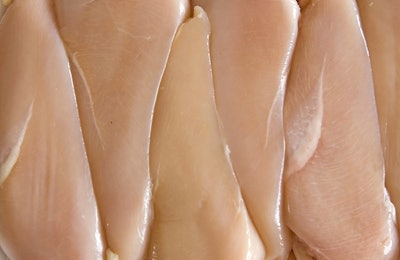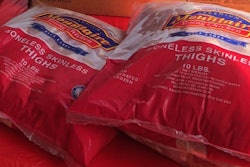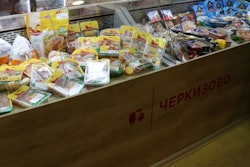
The post COVID-19 world may create even greater demand for automation as poultry processors must deal with new demand flows and social distancing challenges in the plant.
Ahead of the 2021 International Production & Processing Expo (IPPE) Marketplace week, held between Jan. 25-29, 2021, Marel hosted a virtual event on Jan. 20, 2021, reviewing what it markets to assist poultry processors looking for automated solutions for deboning, sorting, weighing and other jobs in the plant.
Breast cap deboning
Jay Russell, a key account manager for Marel, said chicken is the No. 1 protein consumed in North America, and boneless products continue to increase in popularity. The global pandemic and other market forces are shifting behavior as consumers eat more meals at home and foodservice demand sags. These changes, along with new COVID-19 practices in the plant, put more stress on the processor. Russell said automation can be a solution for those seeking flexibility to adapt to market changes and a way to address labor shortages. Further automation in the industry, he said, will lead to a more efficient and safer working environment.
Specifically, Marel wanted to focus on breast cap deboning. This practice began decades ago elsewhere in the world due to labor shortages and its time may be arriving in North America, too.
Deboning
Randy Wilson, a territory account manager for Marel, spoke about products to help processors who need manual and automatic deboning solutions.
First, he featured Marel’s StreamLine: a manual deboning and trimming line designed to increase yield, throughput and meat quality. Wilson said the deboning line weighs both incoming and finished product, calculates the deboning team’s individual and collective performance and ranks the performance of the crew to provide real-time data for the processor. This way, management can identify what needs improvement and get feedback on yield, capacity and quality.
Second, he reviewed its automated deboning products, the AMF-I breast cap filleting machine and FHF-XB front half fileting machine. The AMF, he said, is the world’s most popular deboning machine, and Marel added improvements to create the AMF-I. This product adds intelligence and a heavy duty version is available for processing larger birds. The FHF-XB can run as quickly as seventy birds a minute, function with both large and small birds and function as a modular system producing a wide range of products, including butterflies, fillets, tenders and whole wings.
After deboning, detection of bones is becoming more essential. Wilson said Marel’s SensorX is the best bone detection system available with the world’s largest install base. The device uses X-ray technology to find small bones with the least amount of false positives. The SensorX can also sort boneless breast meat into different weight categories. The device is designed to be integrated with other Marel devices.
Batching and sorting
Fixed weight batching, Wilson said, is becoming more important — partially due to the pandemic — because consumers are changing the way they buy poultry meat. More retailers, fast food chains and foodservice providers are demanding products that require batching solutions, he said.
Marel’s products, he said, are designed to aid in creating retail and export packs. Its range of multi-headed weighers can handle a range of fresh products including bone-in whole legs, drumsticks, thighs, wings, boneless breast meat fillets, tenders, cubes or strips. They also work with dry or wet marinated products and are designed to minimize giveaway and maximize profitability.
For cryo-pack operations, Marel’s line of RoboBatcher products work to improve batching of breast filets and leg products for tray packing. They are designed to minimize giveaway and can process up to 300 filets per minute.
AMF-I
Moore took a closer look at the AMF-I. The I, he said, stands for intelligence and the device utilizes automated measurements of the length of individual breast caps, rather than the weight, to improve processing. The device can process caps up to 1,250 grams and work as quickly as 70 caps per minute.
The device features numerous improvements including: an enhanced touchscreen that’s easier to operate and make quick adjustments; a wider loading unit to place the caps; a stronger product carrier to provide better yields from bigger birds.
Moore said these improvements, and the measurement technology, leads to better yields. He said the device can deliver the best pounds per man hour at the lowest cost per pound, leading to maximum profitability.
Moore brought in Walt Schafer, Lincoln Premium Poultry’s chief operating officer, to speak about the device. He said the plant, which processes birds to be sold by Costco Wholesale Corp., is using the AMF-I which helps eliminate the need for rework, improves quality and helps reduce the need for labor in the plant.
Read more from IPPE Marketplace.


















